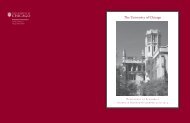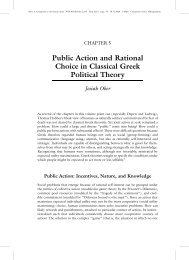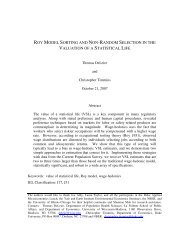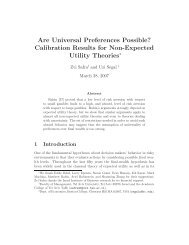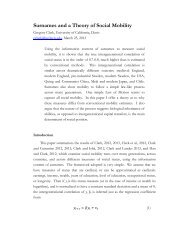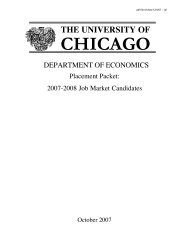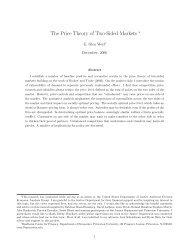CHICAGO - University of Chicago Department of Economics
CHICAGO - University of Chicago Department of Economics
CHICAGO - University of Chicago Department of Economics
Create successful ePaper yourself
Turn your PDF publications into a flip-book with our unique Google optimized e-Paper software.
5480 S Ridgewood Ct<br />
<strong>Chicago</strong>, IL 60615<br />
(773) 396 7897<br />
MATHIS WAGNER<br />
mwagner@uchicago.edu<br />
http://home.uchicago.edu/~mwagner<br />
EDUCATION Ph.D. in <strong>Economics</strong> <strong>University</strong> <strong>of</strong> <strong>Chicago</strong> (expected) June 2009<br />
M.A. in <strong>Economics</strong> <strong>University</strong> <strong>of</strong> <strong>Chicago</strong> December 2003<br />
B.A. in <strong>Economics</strong> Cambridge <strong>University</strong>, UK June 1999<br />
FIELDS Primary: Labor <strong>Economics</strong>, Applied Microeconomics / Price Theory<br />
Secondary: Experimental <strong>Economics</strong>, Industrial Organization, Public <strong>Economics</strong><br />
JOB MARKET<br />
PAPER<br />
WORKING<br />
PAPERS<br />
“Understanding the Labor Market Impact <strong>of</strong> Immigration”<br />
Using Austrian panel data I show that the effect <strong>of</strong> immigration on native wages and employment varies<br />
across industries (for example, on average it is positive in manufacturing and negative in services). By<br />
combining an IV approach with an explicit modeling <strong>of</strong> native labor decisions (thus dealing with both the<br />
endogeneity <strong>of</strong> immigrant and native labor flows) I am able to explain these findings in terms <strong>of</strong> scale and<br />
substitution effects and the elasticity <strong>of</strong> labor supply. Previous approaches are not able to identify scale<br />
effects and so can only estimate the impact <strong>of</strong> immigration on relative wages <strong>of</strong> groups <strong>of</strong> workers.<br />
Finally, I show that the data is consistent with a model <strong>of</strong> task specialization, which explains why lowskilled<br />
immigration can increase average wages even for low-skilled natives.<br />
“Pension Benefits and Retirement Decisions: Income versus Price Effects” (with D. Manoli)<br />
Using Austrian administrative data and multiple pension reforms between 1984 and 2003 we separately<br />
identify income and price effects from pension benefits on retirement. We find an elasticity <strong>of</strong> the<br />
retirement hazard with respect to benefits <strong>of</strong> 1.9, most <strong>of</strong> which (85%) is due to the price effect.<br />
“An Introduction to Optimal Sample Arrangements” (with J. List and S. Sad<strong>of</strong>f) submitted<br />
We provide simple rules <strong>of</strong> thumb that researchers can apply to improve the efficiency <strong>of</strong> their<br />
experimental designs. We buttress these points by including empirical examples from the literature.<br />
“Gender Differentials over the Lifecycle”<br />
Using panel data on cohorts <strong>of</strong> Austrians I decompose gender wage differences over the lifecycle. Lower<br />
wages in female occupations accounts for the initial gap (around 15%). Subsequent widening <strong>of</strong> the gap is<br />
primarily due to one-<strong>of</strong>f falls in wages after childbirth, differences in accumulation <strong>of</strong> experience and<br />
tenure account for the rest, whereas returns to experience and tenure are very similar across genders.<br />
TEACHING<br />
FELLOWSHIPS &<br />
AWARDS<br />
Lecturer, <strong>University</strong> <strong>of</strong> <strong>Chicago</strong><br />
Introduction to Labor <strong>Economics</strong> (undergraduate)<br />
Teaching Assistant, <strong>University</strong> <strong>of</strong> <strong>Chicago</strong><br />
Microeconomics (R. Topel, Graduate School <strong>of</strong> Business)<br />
Public Policy / Wage Inequality (D. Autor, undergraduate)<br />
Intro to Microeconomics, Intro to Macroeconomics (A.<br />
Sanderson), Intermediate Microeconomics (G. Tsiang)<br />
Esther and T.W Schultz Endowment Fellowship<br />
Sherwin Rosen Fellowship<br />
<strong>University</strong> <strong>of</strong> <strong>Chicago</strong> Fellowship<br />
2006, 2008<br />
2006, 2007, 2008<br />
2007<br />
2004-2006<br />
2006-2009<br />
2004-2006<br />
2003-2006<br />
SELECTED<br />
PRESENTATIONS<br />
REFEREE<br />
EMPLOYMENT<br />
<strong>University</strong> <strong>of</strong> <strong>Chicago</strong>: Applications Workshop (2006-08), Applied Microeconomics W.G.<br />
(2004-08); Federal Reserve Bank <strong>of</strong> <strong>Chicago</strong> (2007); <strong>University</strong> <strong>of</strong> Illinois at <strong>Chicago</strong> (2007)<br />
Journal <strong>of</strong> Political Economy<br />
Economist, HM Treasury, UK (September 1999 – June 2002): Productivity and Structural<br />
Reform Team, Fiscal and Macroeconomic Policy Team.<br />
REFERENCES<br />
Robert Topel (chair)<br />
Jonathan Guryan<br />
Steven Levitt<br />
John List<br />
(773) 702-7524<br />
(773) 834-5967<br />
(773) 834-1862<br />
(773) 702-6576<br />
robert.topel@chicagogsb.edu<br />
jonathan.guryan@chicagogsb.edu<br />
slevitt@uchicago.edu<br />
jlist@uchicago.edu




